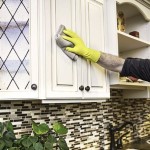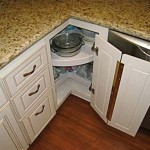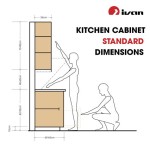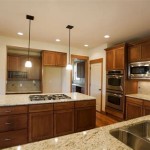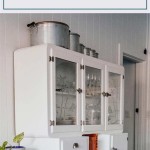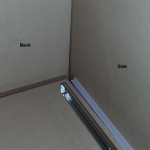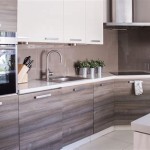Changing Kitchen Cabinet Hinges From Outside to Inside
Changing kitchen cabinet hinges from an outside mount to an inside mount can significantly alter the cabinet's appearance and functionality. This conversion requires careful planning and precise execution to ensure proper alignment and operation. This article outlines the process and considerations for undertaking this project.
Before beginning the conversion, it's essential to identify the type of hinges currently installed. European-style concealed hinges are commonly used for inside mounts. Understanding the existing hinge configuration will inform the necessary steps for removal and the appropriate replacement hinge selection.
Accurate measurements are crucial for a successful conversion. Measure the existing hinge positions precisely, noting the distance from the edge of the cabinet door to the center of the hinge cup hole. This measurement will guide the positioning of the new inside mount hinges. Additionally, measure the thickness of the cabinet door and the overlay, which is the amount the door overlaps the cabinet frame. This determines the correct type of inside mount hinge required.
Once measurements are taken, select appropriate inside mount hinges. These hinges come in various styles, including full overlay, half overlay, and inset. The chosen hinge type depends on the desired overlay and the construction of the cabinet frame. Consulting with a hardware specialist can assist in selecting the correct hinge type and ensuring compatibility with the existing cabinet doors and frames.
With the new hinges selected, begin the removal of the old outside mount hinges. Using a screwdriver, carefully remove the screws securing the hinges to the cabinet door and frame. It is recommended to keep track of all screws and hardware components for potential reuse or future reference. Label each hinge and its corresponding location to simplify reinstallation if necessary.
After removing the old hinges, fill the existing screw holes on the cabinet door and frame. Wood filler is a suitable option for this task. Apply the filler, allowing it to dry completely according to the manufacturer's instructions. Once dry, sand the filled area smooth and level with the surrounding surface to ensure a clean finish for the new hinge installation.
Next, position the new inside mount hinges on the cabinet door. Use the previously taken measurements to ensure accurate placement. Mark the locations of the screw holes with a pencil. Pre-drilling pilot holes at these marked locations is recommended to prevent wood splitting and ensure secure fastening.
Attach the hinges to the cabinet door using the appropriate screws. Ensure the hinges are aligned correctly and sit flush against the door surface. Avoid overtightening the screws, which could damage the hinges or the cabinet door.
With the hinges attached to the door, carefully align the door with the cabinet frame. Mark the locations of the hinge plate screws on the cabinet frame. Again, pre-drilling pilot holes is recommended before screwing the hinge plates into the cabinet frame.
Attach the hinge plates to the cabinet frame, ensuring proper alignment with the hinges on the door. Close the cabinet door to check for proper alignment and smooth operation. Adjustments to the hinge screws may be necessary to achieve optimal functionality.
Fine-tuning the hinge adjustments is crucial for smooth door operation. Most inside mount hinges offer adjustments for depth, height, and side-to-side alignment. Utilize these adjustment screws to achieve a consistent reveal and prevent the door from rubbing against the frame.
After completing the hinge conversion, inspect the cabinet door for proper closure and alignment. Ensure the door closes completely without gaps and operates smoothly without binding or resistance. Adjustments to the hinges may be required to achieve optimal performance.
The conversion from outside mount to inside mount hinges can enhance the aesthetics and functionality of kitchen cabinets. Careful planning, accurate measurements, and precise installation are critical for a successful outcome. Following the outlined steps and considering the specific requirements of the existing cabinets will contribute to a smooth and efficient conversion process.
Addressing potential challenges proactively is essential. Inconsistent cabinet frame dimensions or variations in door thickness might require shimming or additional adjustments during the installation process. Having appropriate shims on hand can facilitate these adjustments and ensure proper alignment.
Selecting high-quality hinges is important for long-term durability and performance. Hinges constructed from robust materials and featuring smooth operating mechanisms contribute to a more satisfying and enduring result. Investing in quality hardware can significantly enhance the overall functionality and longevity of the cabinet doors.

How Do You Switch Cabinet Hinges From Outside To Inside Hometalk

Hinges Installation Trick For Cabinets Young House Love

Replacing Cabinet Hinges With Overlay Self Closing The Palette Muse

Replacing Rusty Kitchen Cabinet Hinges Handyman Singapore

Replacing Outdated Cabinet Hinges The Hardware Hut

The Ultimate Guide To Kitchen Cabinet Hinges

Update Your Kitchen Thinking Hinges Evolution Of Style

Update Your Kitchen Thinking Hinges Evolution Of Style

How To Adjust Cabinet Hinges Bob Vila

Update Your Kitchen Thinking Hinges Evolution Of Style
Related Posts


